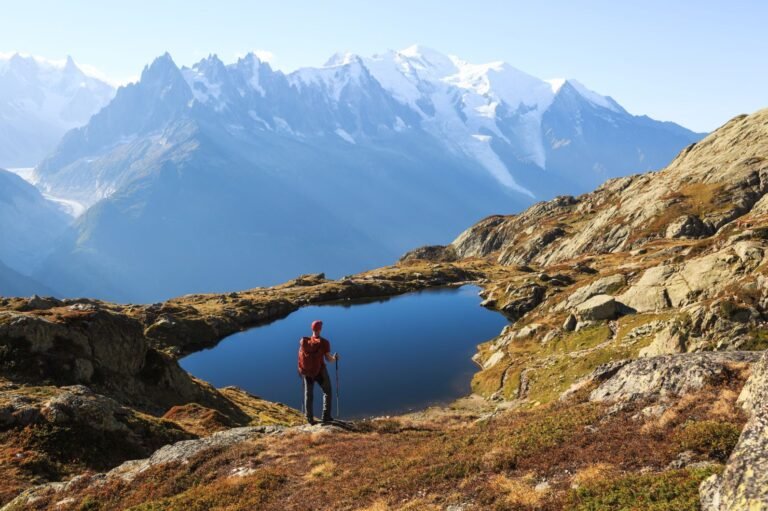Discover the most scenic and challenging Alps hiking trails for 2025. From beginner paths to expert treks, find your perfect alpine adventure here.
Best Alps Hiking Trails to Explore in 2025
The Alps are among the most iconic mountain ranges in the world, stretching across eight European countries including France, Switzerland, Italy, Austria, and Germany. Known for their breathtaking beauty, alpine meadows, glacial lakes, and dramatic peaks, the Alps have long been a dream destination for hikers of all skill levels.
Alpine hiking began as early as the 18th century when explorers and scientists sought to understand the geology and climate of these majestic mountains. Today, modern-day adventurers flock to the Alps not only for the challenging trails but also for the serenity and connection with nature they offer.
Whether you’re an experienced mountaineer or a casual walker, there’s something in the Alps for everyone—from high-altitude treks to charming valley walks.

Best Time to Hike the Alps
Timing your hike can make or break your experience. The best time to hike the Alps is generally from late June to early September, when the snow has melted, trails are clear, and mountain huts are open.
- Spring (May – early June): Beautiful wildflowers but snow still covers higher altitudes.
- Summer (Late June – August): Ideal for high-altitude hiking and longer daylight.
- Autumn (September – October): Fewer crowds and vibrant foliage, but some huts may close.
- Winter (November – April): Not suitable for hiking; better for skiing and snowshoeing.
Avoid peak tourist times if you’re looking for solitude, but do check weather forecasts and trail conditions before setting out.
Essential Gear for Hiking in the Alps
A successful alpine hike begins with proper gear. Here’s what you need:
- Footwear: Sturdy, waterproof hiking boots with ankle support.
- Clothing: Layered clothing suitable for changing weather. Include a rain jacket and thermal base layers.
- Navigation Tools: GPS device, offline trail maps (e.g., Komoot or AllTrails), and a compass.
- Backpack Must-Haves: Sunscreen, reusable water bottle, snacks, first-aid kit, trekking poles, headlamp, and multi-tool.
Safety is paramount—never underestimate how quickly the weather can change in the Alps. Always inform someone of your route and expected return time.
Top Multi-Day Hiking Trails in the Alps
Tour du Mont Blanc (France, Italy, Switzerland)
This legendary 170km loop circles Mont Blanc and passes through three countries. Expect awe-inspiring alpine views, charming villages, and diverse landscapes over 10-12 days.
Alta Via 1 (Italy)
Winding through the Dolomites, Alta Via 1 offers craggy peaks, green valleys, and rifugios (mountain huts) with hearty Italian meals. Ideal for intermediate to experienced hikers.
Haute Route (Chamonix to Zermatt)
A classic high-level route connecting Mont Blanc and the Matterhorn. Known for its difficulty and breathtaking glacial views, this is for serious trekkers.
Stubai High Trail (Austria)
This loop in the Stubai Alps covers 80km with panoramic ridgelines and overnights in well-equipped huts. Each day offers a different alpine marvel.

Best Day Hikes in the Alps
Five Lakes Walk (Switzerland)
Near Zermatt, this family-friendly hike offers postcard views of the Matterhorn reflected in five serene alpine lakes.
Lauterbrunnen Valley Hike (Switzerland)
With 72 waterfalls, this valley looks like a fairy tale. The trail is relatively easy and great for beginners.
Eagle Walk (Austria)
A long-distance trail broken into manageable stages. Choose a segment that suits your ability and explore the Tyrolean Alps.
Hidden Gem Trails in the Alps
Not all Alps hiking trails are world-famous, and that’s part of the charm. These lesser-known paths offer serenity and natural beauty without the crowds.
Gemsstock Glacier Trail (Switzerland)
A high-altitude hike near Andermatt, this trail provides views of the Gotthard massif and access to glacier formations. It’s best for experienced hikers comfortable with icy terrain.
Triglav Lakes Valley (Slovenia)
Nestled within Triglav National Park, this trail showcases crystal-clear lakes and dramatic limestone peaks. Though Slovenia isn’t always the first choice for alpine trekking, it’s a hidden treasure.
Val di Mello Trail (Italy)
Located in Lombardy, Val di Mello is often called Italy’s Yosemite. With granite cliffs, peaceful meadows, and gentle streams, it’s ideal for a scenic, moderate hike.
Difficulty Levels of Alps Hiking Trails
The Alps cater to all levels of hikers, but knowing your limits is crucial.
- Easy Trails: Generally short and well-marked. Ideal for families and beginners (e.g., Five Lakes Walk).
- Moderate Trails: Require good fitness and some elevation gain (e.g., Alta Via 1).
- Challenging Trails: High elevation, technical terrain, and multi-day treks (e.g., Haute Route, Tour du Mont Blanc).
Many trail guides and local tourism offices provide detailed grading systems—always check before you go.
Family-Friendly Trails in the Alps
If you’re traveling with children or older adults, there are many enjoyable and safe options.
- Schynige Platte Panorama Trail (Switzerland): A short loop with panoramic views and a botanical alpine garden.
- Lake Achensee Trail (Austria): A flat lakeside walk perfect for strollers.
- Adventure Trails: Many regions offer themed trails with interactive signs and games, such as the “Marmot Trail” in the Dolomites.
Look for playgrounds, nearby lodges, and short loop options to keep the experience light and fun.

Wildlife and Flora You’ll Encounter
The Alps are a haven for biodiversity. While hiking, keep your eyes peeled for:
- Wildlife: Alpine ibex, marmots, chamois, and golden eagles.
- Flora: Edelweiss (symbol of the Alps), alpine roses, and gentians.
Respect nature—do not feed or disturb wildlife, and stay on marked trails to protect fragile ecosystems.
Accommodation Options on the Trails
Accommodations range from rustic to luxurious:
Type Description
Mountain Huts (Refuges/Rifugi) Basic shared dorms with meals. Need early booking in peak season.
Camping Legal in designated areas. Wild camping is regulated or forbidden in many regions.
Local Inns & Lodges Found in villages along the trail. Offer more comfort and amenities.
Booking ahead is especially important on popular trails like the Tour du Mont Blanc.
Food and Dining in the Alps While Hiking
You’ll never go hungry in the Alps:
- Trail Snacks: Bring dried fruits, nuts, protein bars, and plenty of water.
- Hut Cuisine: Enjoy local favorites like rösti, polenta, schnitzel, and Kaiserschmarrn.
- Local Delicacies: Try alpine cheeses, cured meats, and fresh pastries in valley towns.
Always carry some emergency food, especially on longer or remote hikes.
Trail Safety and Etiquette
Hiking in the Alps is safe if you’re prepared:
- Weather: Sudden storms are common—carry a waterproof layer and always check the forecast.
- Leave No Trace: Pack out all trash and respect nature.
- Trail Etiquette: Greet fellow hikers, yield to uphill hikers, and don’t stray from marked paths.
Learn basic first aid and consider carrying an emergency beacon if hiking remote routes.
Guided Tours vs. Self-Guided Hikes
Guided Tours:
- Pros: Local expertise, safety, and hassle-free logistics.
- Cons: Costly and less flexible.
Self-Guided Hikes:
- Pros: Freedom, cost-effective, and customizable.
- Cons: Requires more planning and map-reading skills.
Choose what fits your confidence and experience level.
Popular Hiking Events and Festivals in the Alps
Celebrate your passion for hiking at these events:
- Eiger Ultra Trail (Switzerland): A high-endurance challenge through the Bernese Alps.
- Dolomiti Trekking Festival (Italy): A family-friendly gathering with guided walks and local food.
- AlpenTestival (Germany): Try out new hiking gear, meet like-minded trekkers, and attend workshops.
Joining an event can add community spirit to your alpine adventure.
How to Get to the Alps Hiking Trails
Access is easy thanks to Europe’s transport network:
Country Closest Airports Major Hiking Areas
Switzerland Zurich, Geneva Zermatt, Jungfrau, Engadin
France Geneva, Lyon Chamonix, Mercantour
Italy Milan, Venice Dolomites, Aosta Valley
Austria Innsbruck, Salzburg Tyrol, Stubai Alps
Use trains and buses to reach even remote trailheads. Switzerland, in particular, offers seamless transport links.
Permits, Passes, and Local Regulations
Generally, no permits are required for day hikes, but:
- Protected Parks: May require passes (e.g., Triglav National Park).
- Camping Rules: Wild camping is restricted in most alpine areas.
- Border Crossings: Schengen rules apply—carry ID when trails pass between countries.
Always check with local tourism offices or park websites before you go.
Frequently Asked Questions (FAQs)
1. Do I need a guide to hike in the Alps?
No, many trails are well-marked. However, beginners may benefit from guided hikes, especially on high-altitude routes.
2. What’s the safest country to hike in the Alps?
All alpine countries are generally safe. Switzerland is known for well-maintained trails and efficient rescue services.
3. How many days should I spend hiking the Alps?
You can do a rewarding day hike or embark on a 10-14 day trek like the Tour du Mont Blanc. It depends on your goals and fitness.
4. Can I hike with kids in the Alps?
Absolutely. Choose family-friendly routes like the Five Lakes Walk or themed trails designed for young hikers.
5. What if I encounter bad weather?
Turn back or seek shelter at the nearest hut. Alpine storms can be sudden and dangerous—never take risks.
6. Are dogs allowed on the trails?
Yes, most trails are dog-friendly, but leashing may be required, especially near livestock or in protected areas.
Embark on Your Ultimate Alps Adventure
Hiking in the Alps is more than a physical journey—it’s an emotional and spiritual one. The majesty of these mountains, the camaraderie among hikers, and the diversity of landscapes make every step unforgettable. Whether you’re chasing summits or soaking in tranquil valleys, the Alps offer something magical for everyone.
Now lace up your boots, grab your backpack, and let the Alps lead you to your next great adventure.





